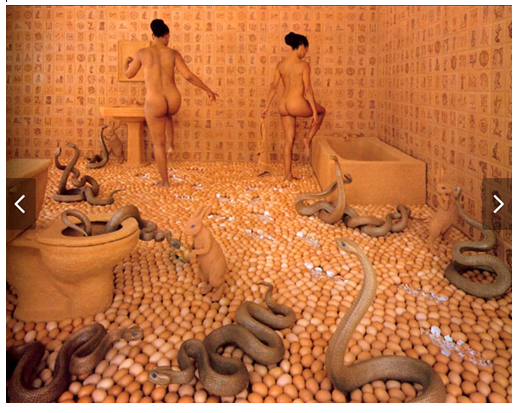
Understanding of the Image
Walking on eggshells is a photograph by Sandy Skoglund, which depicts two women in a room with snakes, eggs, and rabbits on the floor. The two women are close together and one has her arm stretched towards the other, who is holding a towel. They both have one foot off the ground, one is close to a bathtub, presumably close to entering it, while another is in front of a sink (Skoglund, 1997). The snakes on the floor are spread out in the room, some facing the women while others face varied directions. The eggs are of distinct shades of colors like the snakes. Some of the eggs are broken a d depict a path followed by the women to their various final positions in the room. The two women are naked and their feminine body features are well depicted with their hair tied in one knot.
Snakes are emanating from the toilet while others are tangled together around each other’s bodies. Three rabbits in the room stand in front of the snakes and appear to be holding the eggs to them as if feeding them. The walls of the room contain signs and figures which are not distinctly clear but seem repeated countless times. The snakes vary in their sizes with some bigger than others. The walls of the room and the eggs have a smooth texture appearance while the bathtub and the toilet seat appear rough in texture.
Styles in the Image
The most predominant style used in the photograph is repetition, with the artist repeating various features. The snakes are repeated across the entire room, the eggs fill the entire floor except the areas occupied by the bathtub and toilet seat. There are three rabbits in the room, another evidence of repetition by the artist. The repetition of various features in a photograph grasps the attention of a viewer (Skoglund, 1997). The reiteration triggers curiosity and a view is thrilled to take a closer view to distinguish the similar objects in the photos. The reappearance sharpens the senses of the viewer to the endless possibilities within the photograph, and puts their mind at ease. The photographer paid keen attention to the bold shading and intense coloring of the photograph. The coloring helps enhance clarity while showing the differences between various structures.
The interpretation of the image depicts a real-life scenario, with the snakes indicating the various dangers that exist within life. The eggs depict the various risks that exist in life, presuming that the eggs belong to the snakes. The women are representative of real people who are oblivious to the danger in their surroundings as they face away from the snake. The rabbits indicate the aware people in the society who are knowledgeable about the dangers around them. They are forced to appease the source of the danger by serving them to preserve their lives, given the fatal nature of snakes and their ability to kill.
The use of the rabbits for this demonstration, as they are considered cunning, indicates the perception people have towards those aware of dangers. The vigilance of wise and aware people who choose to appease the oppressors is widely regarded as craftiness. The object in front of the girl near the sink is supposed to be a mirror that would reflect what is behind her, and warn her. The absence of a mirror and instead an opaque background indicates the hopelessness of life when danger strikes and no help is availed.
Work Cited
Skoglund, Sandy. (1997). Walking on eggshells. Sandy skoglund. Web.